There was a considerable focus on marketing at last week’s national potato conference.
Delegates were told how the declining trend in potato consumption appears to have been reversed with the 2019 annual consumption of 209,179.1t rising to 219,077.9t in 2022.
The intervening two years of COVID-19 restrictions saw average consumption rise above 240,000t, an increase that was mainly attributed to people having more time to cook.
Looking at current trends, Eimear Faughnan from Kantar Worldpanel commented that more shoppers are now tending to buy smaller packs of potatoes in response to food inflation, which she put at 13.4% for 2022.
A comment from the floor asked why supposedly well-educated and intelligent millennials seeking value in their shopping baskets would opt for smaller-pack sizes, which cost more per kilo and have higher packaging costs? If saving money is the objective, then larger packs present better value to those who are supposedly trying to save money.
Eimear replied that such decisions were largely based on weekly budgeting rather than value calculations.
The importance of having potatoes in the shopping trolley remains a big consideration for the large retailers, Eimear said. They continue to associate the presence of potatoes in the trolley as being a bigger shopping, which is important for them for market share.
Recent experience here has shown that the actual cost of the potatoes does not really matter to the consumer but it does matter to retailers. This makes potatoes prone to a race to the bottom at retail level.
During discussion, growers threatened to take action if any of the big retailers use potatoes as a driver for promotional campaigns in the lead-up to Christmas.
Potatoes are still a very important (the most important) source of carbohydrate for Irish consumers in comparison to other options like rice or pasta or other alternatives.
They also represent extremely good value for money to consumers despite the fact that they are priced on a fresh-weight basis.
A recent push to increase the use of native potatoes in family-owned chippers appears to be making good progress too.
The conference was told about a number of chippers who have made a successful move to use Irish potatoes and this seems to be going very well.
Siobhán Collins of Bord Bia was behind the project. She said that a survey of chipper customers found that the majority of chip buyers assumed they were made from Irish potatoes. But this is not the case and this specific market has been mainly supplied by imports from the UK for years.
Irish potatoes were tried in the past with very variable results. Siobhán’s research emphasised that for the chippers, consistency and repeatability of their chips is paramount to their reputation and their businesses.
British potato imports have served them well and any alternative supply source would have to at least equal the performance of imported product.
A number of co-operations between individual growers and chippers have already taken place without outside intervention.
Siobhán said that a Bord Bia initiative now provides a platform for both parties to help fulfil the desires of those involved in the survey.
Many of those surveyed said they would seek out chippers that sold chips produced from Irish-grown potatoes.
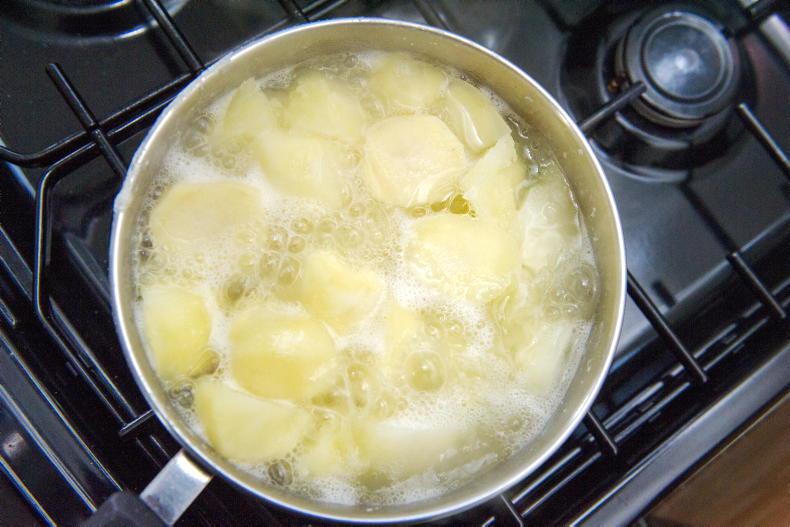
There are many other ways in which potatoes can be prepared for eating other then the traditional boiling. \ Barry Cronin
In this regard, Bord Bia are now providing promotional materials for chippers to help them verify that they are using Irish-grown potatoes for their chips.
It is hoped that this continuing co-operation between chippers and growers will help to displace more and more of the 70,000t of potatoes imported annually, much of which has been destined for the chipper trade up to now.
The initial survey also found that 73% of customers say they would seek out chippers that used Irish product. And 40% said they would pay more for those real Irish-produced chips.
Users and suppliers
Chipper operator, Dario Macari from Romayo’s, told the audience that their long relationship with Flynns has enabled them to source Irish potatoes and produce and sell Irish chips for many years. He said that they would use more if they could get enough of the quality they require. “Where else should anyone expect to get better potatoes than in Ireland,” Dario said.
John Geary of Meadowfresh Foods in Tallow told those in attendance about a collaboration that his company is doing with O’Shea Farms in Piltown. The venture is to provide a supply chain for the Irish chipper trade. Meadowfresh is now sourcing and assembling potatoes for the fresh chipping market.
Specific varieties are grown by growers and managed by a dedicated agronomist to help ensure that the product performs equally well for all chipper customers.
They supply fresh chipping potatoes in 25kg, 15kg and 5kg bags and are about to enter the fresh chip market with a 500g pack under the Earthly brand.
Blight challenge continues to grow
In an update on late blight control, Steven Kildea of Teagasc outlined the various changes that have taken place in late blight populations in recent years and the ongoing challenges of control.
He reminded us of the great threat that was posed by the advent of the ‘Blue 13’ strain in 2013 and said that this is now of little importance in the overall population.
This is because many other resistant strains have developed since then. He spoke about the problems that emerged for fluazinam in 2021 and we now have issues with Ranman, thanks to the Green 37 isolate. These changes just keep on happening as we increase the intensity of disease control.
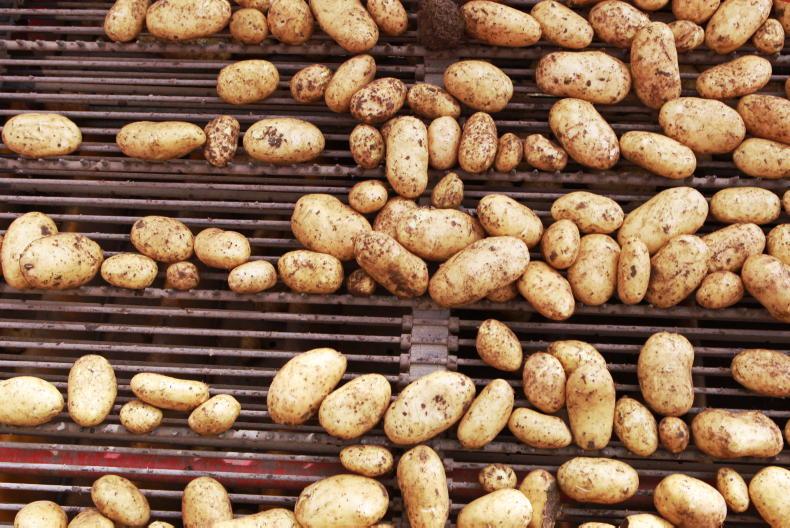
Maris Piper was a major traditional variety of potato for the chipper trade but now other varieties are opening up opportunities for Irish growers and chippers.
Resistance continues to add to the challenges of control, while the number of control agents in the toolbox is being reduced by EU legislation.
Control of late blight is being squeezed at both sides so research and industry must look beyond the traditional control agents. For this reason, research continues to explore potential integrated pest control (IPM) methodology to help sharpen and minimise the use of disease control agents.
As well as these pressures, we must add changing climate patterns which have decreased summer rainfall in recent years.
Steven emphasised that drier summers are fundamentally a good thing for disease control but they add other challenges such as increased need for irrigation.
Considering these three scenarios, Steven asked if we could consider a move away from prophylactic fungicide applications? This would require being able to predict and manage the risk of blight more accurately. In this regard, Teagasc has worked with Met Éireann to produce an improved blight prediction tool.
The new model brings in weather forecast data plus variety resistance information to help the accuracy of fungicide intervention.
Steven said that there was virtually no blight up to the end of August in 2022 but then high early September rainfall brought a big surge in disease incidence. Being able to predict this would have provided an opportunity to save on fungicide application in the early part of the season.
The new model has the ability to decrease the number of applications and the total dose used, depending on the pressures.
Evaluation of the new system has shown it to be very satisfactory at field level, with no hit on either yield of disease incidence despite less intensive treatment. So the use of these new blight risk maps appears to be very worthwhile for potato producers.
The increased cost of production and storage was mentioned frequently during the day. Regarding storage costs, Adrian Cunnington spoke about the need for good planning across the entire business as an essential starting point for good efficiency.
Organising variety choice and crop management to keep harvesting compact is critical to the efficient use of curing and drying facilities in stores.
Refrigerated stores need to be filled quickly and fully to work efficiently. On the flip side, half- or quarter-filled stores are very inefficient if fridges are still running in May to July.
Adrian questioned the target storage temperature and the accuracy with which it can be maintained in stores. He talked about the need to get moisture and temperature out of store and the absolute necessity to prevent condensation to help prevent disease development.
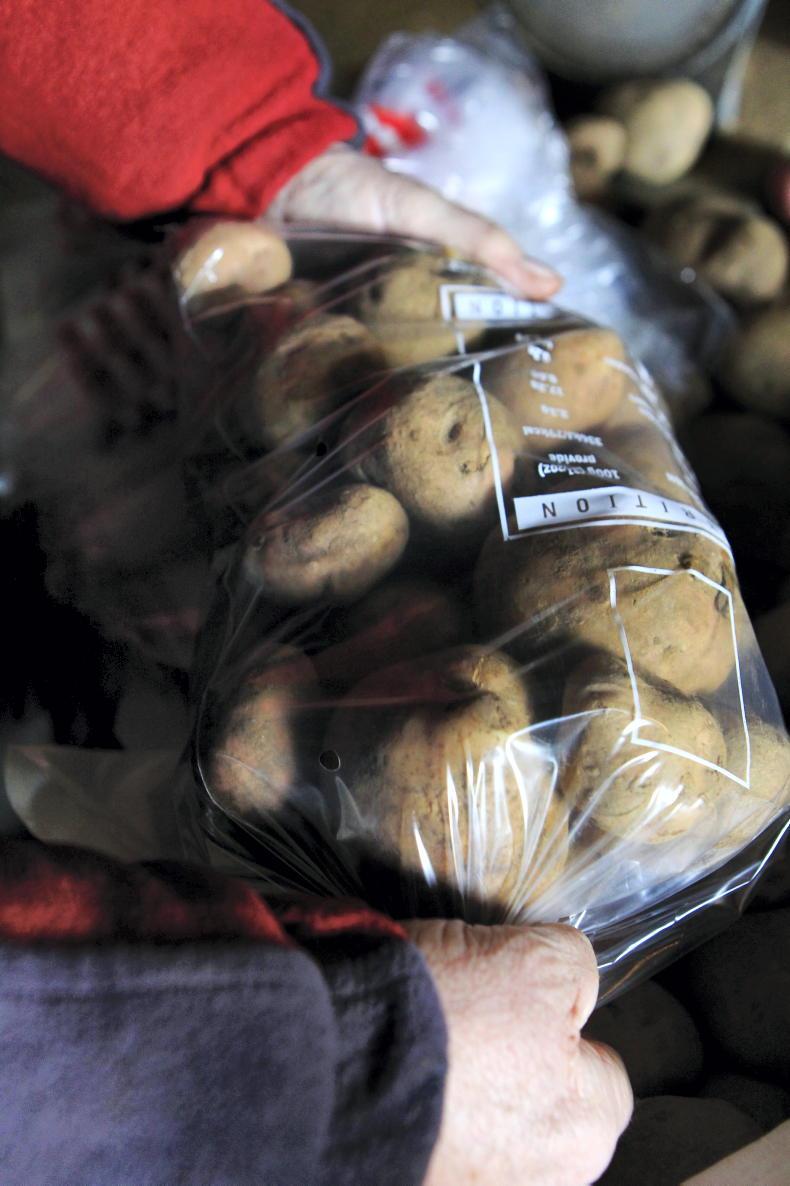
Active promotion has helped stop the decline in potato consumption and actually increase it. \ Ramona Farrelly
Lower temperatures cost more and targets of 2.5 degrees Celsius are mainly used to help prevent silver scurf. “But is that the main problem”, he asked, “because if the ambient temperature could be raised to 3.5 degrees Celsius, the cost of running the store would be much lower”. And if the temperature is slightly higher, the risk of condensation is lower.
In terms of managing storage cost, Adrian advised that the run time on fridges and fans should be matched as closely as possible to tariff rates or the availability of renewables.
He stated that automated controls are critical to help make best use of cost variables while maintaining the required storage conditions and the successful operation of the store.
He went on to say that the default settings in automated control units should not be taken as being totally correct.
He advised that these units be checked and adjusted by professionals where the costs associated with storage appear to be higher than average.
His advice was to always question the default settings.
While control of environmental conditions is important within the store, Adrian said that it is essential that weight loss in store be minimised. This means appropriate use of fans because moving air removes water and running fans cost money to operate.
He said that new electrical control equipment can help to decrease running costs.
He advised that growers should not skimp on fan power and that more efficient fans are now relatively cheap. If a fan can be run at less that full capacity, this gives a dramatic reduction in the energy cost to drive it.
The potato promotion campaign has stopped the decline in consumption and actually raised demand.Industry and Bord Bia efforts to increase the use of Irish potatoes in the fresh chipping market appear to be gaining ground. The improved blight warning system from Teagasc and Met Éireann can help reduce fungicide use for late blight control.Higher electricity charges make it essential to run refrigerated stores as efficiently as possible.
There was a considerable focus on marketing at last week’s national potato conference.
Delegates were told how the declining trend in potato consumption appears to have been reversed with the 2019 annual consumption of 209,179.1t rising to 219,077.9t in 2022.
The intervening two years of COVID-19 restrictions saw average consumption rise above 240,000t, an increase that was mainly attributed to people having more time to cook.
Looking at current trends, Eimear Faughnan from Kantar Worldpanel commented that more shoppers are now tending to buy smaller packs of potatoes in response to food inflation, which she put at 13.4% for 2022.
A comment from the floor asked why supposedly well-educated and intelligent millennials seeking value in their shopping baskets would opt for smaller-pack sizes, which cost more per kilo and have higher packaging costs? If saving money is the objective, then larger packs present better value to those who are supposedly trying to save money.
Eimear replied that such decisions were largely based on weekly budgeting rather than value calculations.
The importance of having potatoes in the shopping trolley remains a big consideration for the large retailers, Eimear said. They continue to associate the presence of potatoes in the trolley as being a bigger shopping, which is important for them for market share.
Recent experience here has shown that the actual cost of the potatoes does not really matter to the consumer but it does matter to retailers. This makes potatoes prone to a race to the bottom at retail level.
During discussion, growers threatened to take action if any of the big retailers use potatoes as a driver for promotional campaigns in the lead-up to Christmas.
Potatoes are still a very important (the most important) source of carbohydrate for Irish consumers in comparison to other options like rice or pasta or other alternatives.
They also represent extremely good value for money to consumers despite the fact that they are priced on a fresh-weight basis.
A recent push to increase the use of native potatoes in family-owned chippers appears to be making good progress too.
The conference was told about a number of chippers who have made a successful move to use Irish potatoes and this seems to be going very well.
Siobhán Collins of Bord Bia was behind the project. She said that a survey of chipper customers found that the majority of chip buyers assumed they were made from Irish potatoes. But this is not the case and this specific market has been mainly supplied by imports from the UK for years.
Irish potatoes were tried in the past with very variable results. Siobhán’s research emphasised that for the chippers, consistency and repeatability of their chips is paramount to their reputation and their businesses.
British potato imports have served them well and any alternative supply source would have to at least equal the performance of imported product.
A number of co-operations between individual growers and chippers have already taken place without outside intervention.
Siobhán said that a Bord Bia initiative now provides a platform for both parties to help fulfil the desires of those involved in the survey.
Many of those surveyed said they would seek out chippers that sold chips produced from Irish-grown potatoes.

There are many other ways in which potatoes can be prepared for eating other then the traditional boiling. \ Barry Cronin
In this regard, Bord Bia are now providing promotional materials for chippers to help them verify that they are using Irish-grown potatoes for their chips.
It is hoped that this continuing co-operation between chippers and growers will help to displace more and more of the 70,000t of potatoes imported annually, much of which has been destined for the chipper trade up to now.
The initial survey also found that 73% of customers say they would seek out chippers that used Irish product. And 40% said they would pay more for those real Irish-produced chips.
Users and suppliers
Chipper operator, Dario Macari from Romayo’s, told the audience that their long relationship with Flynns has enabled them to source Irish potatoes and produce and sell Irish chips for many years. He said that they would use more if they could get enough of the quality they require. “Where else should anyone expect to get better potatoes than in Ireland,” Dario said.
John Geary of Meadowfresh Foods in Tallow told those in attendance about a collaboration that his company is doing with O’Shea Farms in Piltown. The venture is to provide a supply chain for the Irish chipper trade. Meadowfresh is now sourcing and assembling potatoes for the fresh chipping market.
Specific varieties are grown by growers and managed by a dedicated agronomist to help ensure that the product performs equally well for all chipper customers.
They supply fresh chipping potatoes in 25kg, 15kg and 5kg bags and are about to enter the fresh chip market with a 500g pack under the Earthly brand.
Blight challenge continues to grow
In an update on late blight control, Steven Kildea of Teagasc outlined the various changes that have taken place in late blight populations in recent years and the ongoing challenges of control.
He reminded us of the great threat that was posed by the advent of the ‘Blue 13’ strain in 2013 and said that this is now of little importance in the overall population.
This is because many other resistant strains have developed since then. He spoke about the problems that emerged for fluazinam in 2021 and we now have issues with Ranman, thanks to the Green 37 isolate. These changes just keep on happening as we increase the intensity of disease control.

Maris Piper was a major traditional variety of potato for the chipper trade but now other varieties are opening up opportunities for Irish growers and chippers.
Resistance continues to add to the challenges of control, while the number of control agents in the toolbox is being reduced by EU legislation.
Control of late blight is being squeezed at both sides so research and industry must look beyond the traditional control agents. For this reason, research continues to explore potential integrated pest control (IPM) methodology to help sharpen and minimise the use of disease control agents.
As well as these pressures, we must add changing climate patterns which have decreased summer rainfall in recent years.
Steven emphasised that drier summers are fundamentally a good thing for disease control but they add other challenges such as increased need for irrigation.
Considering these three scenarios, Steven asked if we could consider a move away from prophylactic fungicide applications? This would require being able to predict and manage the risk of blight more accurately. In this regard, Teagasc has worked with Met Éireann to produce an improved blight prediction tool.
The new model brings in weather forecast data plus variety resistance information to help the accuracy of fungicide intervention.
Steven said that there was virtually no blight up to the end of August in 2022 but then high early September rainfall brought a big surge in disease incidence. Being able to predict this would have provided an opportunity to save on fungicide application in the early part of the season.
The new model has the ability to decrease the number of applications and the total dose used, depending on the pressures.
Evaluation of the new system has shown it to be very satisfactory at field level, with no hit on either yield of disease incidence despite less intensive treatment. So the use of these new blight risk maps appears to be very worthwhile for potato producers.
The increased cost of production and storage was mentioned frequently during the day. Regarding storage costs, Adrian Cunnington spoke about the need for good planning across the entire business as an essential starting point for good efficiency.
Organising variety choice and crop management to keep harvesting compact is critical to the efficient use of curing and drying facilities in stores.
Refrigerated stores need to be filled quickly and fully to work efficiently. On the flip side, half- or quarter-filled stores are very inefficient if fridges are still running in May to July.
Adrian questioned the target storage temperature and the accuracy with which it can be maintained in stores. He talked about the need to get moisture and temperature out of store and the absolute necessity to prevent condensation to help prevent disease development.

Active promotion has helped stop the decline in potato consumption and actually increase it. \ Ramona Farrelly
Lower temperatures cost more and targets of 2.5 degrees Celsius are mainly used to help prevent silver scurf. “But is that the main problem”, he asked, “because if the ambient temperature could be raised to 3.5 degrees Celsius, the cost of running the store would be much lower”. And if the temperature is slightly higher, the risk of condensation is lower.
In terms of managing storage cost, Adrian advised that the run time on fridges and fans should be matched as closely as possible to tariff rates or the availability of renewables.
He stated that automated controls are critical to help make best use of cost variables while maintaining the required storage conditions and the successful operation of the store.
He went on to say that the default settings in automated control units should not be taken as being totally correct.
He advised that these units be checked and adjusted by professionals where the costs associated with storage appear to be higher than average.
His advice was to always question the default settings.
While control of environmental conditions is important within the store, Adrian said that it is essential that weight loss in store be minimised. This means appropriate use of fans because moving air removes water and running fans cost money to operate.
He said that new electrical control equipment can help to decrease running costs.
He advised that growers should not skimp on fan power and that more efficient fans are now relatively cheap. If a fan can be run at less that full capacity, this gives a dramatic reduction in the energy cost to drive it.
The potato promotion campaign has stopped the decline in consumption and actually raised demand.Industry and Bord Bia efforts to increase the use of Irish potatoes in the fresh chipping market appear to be gaining ground. The improved blight warning system from Teagasc and Met Éireann can help reduce fungicide use for late blight control.Higher electricity charges make it essential to run refrigerated stores as efficiently as possible. 







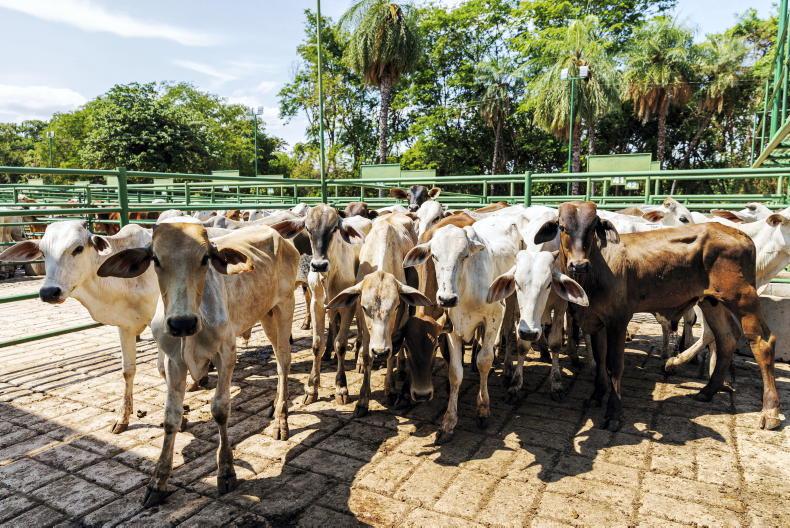

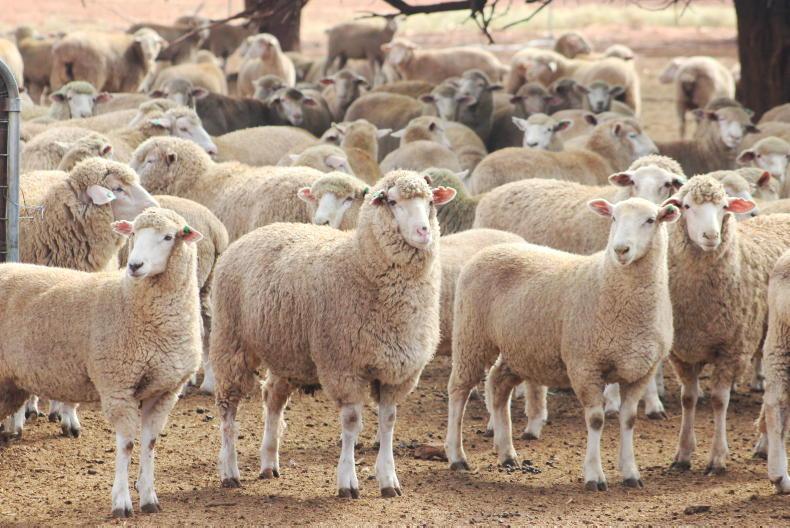


SHARING OPTIONS